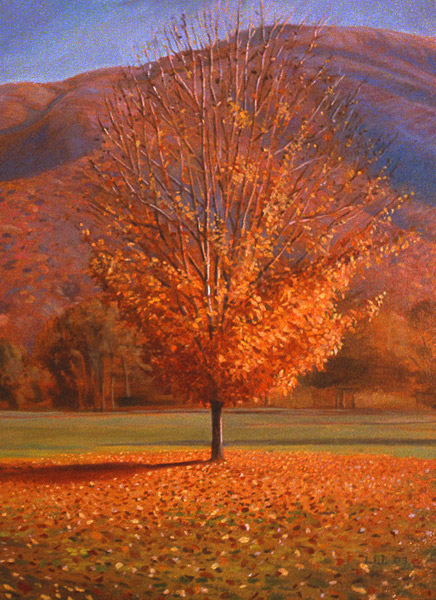Tree
care tips for this fall
The gardening
season isn't over once fall arrives, especially when it comes to your trees.
Fall is an excellent time for planting most trees. It's also important to do
your fall tree care now to prepare them for winter.
 Most trees can
be planted in fall. The temperatures are cooler, stressing the trees less and
allowing them a better chance to get their roots established. It also helps
that by this time in the growing season, some places discount their plant
stock.
Most trees can
be planted in fall. The temperatures are cooler, stressing the trees less and
allowing them a better chance to get their roots established. It also helps
that by this time in the growing season, some places discount their plant
stock.
Young trees are
especially susceptible to the temperature changes that come with winter in cold
climates. They are usually not developed enough to withstand the constant freezing
and thawing that may occur throughout the upcoming winter.
One way to help
combat this is with a thick (3-6")mulch layer. Do not put it right up
against the trunk - this can cause moisture buildup that attracts fungus. Better to build up a circular berm around the
outside canopy at the base of the tree. Shredded cedar would be best to use.
There's a chill
creeping into the air. The leaves are changing colors. Winter is just around
the corner. Now is the time to think about properly watering your trees in
autumn to help ensure against damage in the winter.
In the middle
of winter, the ground is frozen. Trees are not able to access water, so it is
important that you are watering your trees in autumn as necessary. Watering
your trees in early autumn is different than late autumn, so water accordingly.
In early
autumn, you should stop watering your deciduous and evergreen trees. Do not
worry about watering until the leaves have fallen from the deciduous trees.
The trees are
still growing in early autumn and watering will encourage new growth. If a
frost comes when there is new growth on the tree, it will be damaged.
Late Autumn
Once the
deciduous trees have lost their leaves in late autumn, it is time to start
watering again. Evergreen trees will definitely need to be watered before
winter - since they never lose their foliage and go into full dormancy, they
will constantly be losing water throughout the winter.
By late autumn,
the tops of the trees have gone dormant, so they will not produce new growth.
The tree is busy moving nutrients around in preparation for dormancy.
Water deeply
(at least 1-2 feet deep at a time) until the ground is frozen. Deep watering
encourages proper root growth so that the trees will be able to access water
farther down in the soil.
Young trees, especially, need lots of water to establish
roots in preparation for winter. Newly planted trees should be watered at the
base, while more mature trees should be watered at the drip line. The drip line is the area directly located under the outer
circumference of the tree branches. This is where the tiny rootlets are located
that take up water for the tree. Trees should be watered here, not by the base
of the trunk, or the tree may develop root rot.
Watch for signs
that your trees need fertilization. Some signs that may indicate a nutrient
problem are:
Reduced growth
in branches and leaves.
Leaves changing
colors and falling earlier than usual.
Wilting
Fertilizing in
fall can cause rapid new growth, which could be damaged in winter. Consider
fertilizing in spring if possible.
Pruning
Make sure to remove the 3 D's - dead,
diseased or damaged. They all serve as points where diseases or pests could
enter. Removing them will also make the tree look better. You can also prune
branches that aren't growing the way you would like.
Do thin rather
than shear on flowering trees - prune lightly because next year's flower buds
have already been formed, and heavy pruning would affect the next spring's flower
production.
A dormant spray may be a good idea for deciduous trees, ornamentals, fruit trees and shrubs. But remember not to spray until after you prune. Obviously, you will lose much of your effort and expense if you cut off treated limbs.
Choice of chemicals is important. Dormant sprays include lime, copper and sulfur combinations to kill overwintering microorganisms. Dormant oil controls insects and their eggs. You just may need several types of sprays and oils to be effective.
Avoid spraying any of this material in the hot sun as it can damage dormant buds. Get specific chemical recommendations from you local county extension agent.
Question: Jimmie, How long into the fall season should I continue
to mow the lawn? Thanks for your time, I always enjoy learning from your
articles!! Richard P. in Prosper
Answer: Hi Richard, thanks for the kind words. Those of us who
despise mowing can't wait to retire the mower for another year. But don't be
too hasty. Nor should you think that, just because you stopped mowing last year
on such-and-such a date, the same end-date will be valid this year. This
question's a lot easier to answer than you might imagine. Simply continue to
mow the lawn until the grass stops growing!
Weather will determine this, not some artificial deadline. Until next time...Happy Gardening!!
Visit our new website at www.absolutelybushedlandscaping.com
Weather will determine this, not some artificial deadline. Until next time...Happy Gardening!!
Visit our new website at www.absolutelybushedlandscaping.com


No comments:
Post a Comment